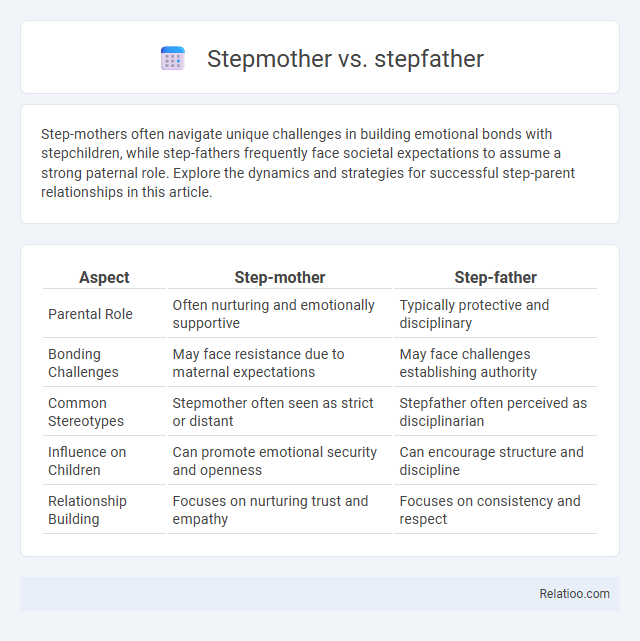Step-mothers often navigate unique challenges in building emotional bonds with stepchildren, while step-fathers frequently face societal expectations to assume a strong paternal role. Explore the dynamics and strategies for successful step-parent relationships in this article.
Table of Comparison
| Aspect | Step-mother | Step-father |
|---|---|---|
| Parental Role | Often nurturing and emotionally supportive | Typically protective and disciplinary |
| Bonding Challenges | May face resistance due to maternal expectations | May face challenges establishing authority |
| Common Stereotypes | Stepmother often seen as strict or distant | Stepfather often perceived as disciplinarian |
| Influence on Children | Can promote emotional security and openness | Can encourage structure and discipline |
| Relationship Building | Focuses on nurturing trust and empathy | Focuses on consistency and respect |
Defining the Roles: Step-Mother vs Step-Father
Step-mother and step-father roles involve complex dynamics shaped by gender expectations and family structure, where a step-mother often navigates nurturing and boundary-setting, while a step-father may focus on protection and leadership within the blended family. Step-parenting requires adapting to the unique needs of stepchildren and biological parents, establishing trust, and managing discipline alongside co-parenting challenges. Understanding these distinctions helps clarify responsibilities, emotional bonds, and strategies for successful integration in step-family systems.
Historical Perspectives on Stepparenting
Historical perspectives on stepparenting reveal evolving roles of stepmothers and stepfathers shaped by cultural norms and legal frameworks. Stepmothers often faced stereotypes as disciplinarians or antagonists in folklore and literature, while stepfathers were commonly viewed as providers and protectors within the family hierarchy. Over time, step-parenting has shifted towards more inclusive and supportive roles, reflecting changes in family structures, legal recognition, and social attitudes towards blended families.
Societal Stereotypes and Gender Expectations
Step-mother, step-father, and step-parenting roles are heavily influenced by societal stereotypes and gender expectations, shaping how each is perceived and treated. Step-mothers often face negative stereotypes as disciplinarians or threats to biological mothers, while step-fathers may be seen as less nurturing but more authoritative figures. Your approach to step-parenting can challenge these biases, promoting healthier family dynamics regardless of gender.
Emotional Challenges Faced by Step-Mothers
Step-mothers often encounter unique emotional challenges in step-parenting, including feelings of rejection and struggles to establish trust with stepchildren. The complexity of navigating loyalties between biological parents and creating new family bonds frequently leads to stress and emotional strain. Understanding the psychological impact on step-mothers is crucial for developing supportive interventions in blended family dynamics.
Unique Struggles for Step-Fathers
Step-fathers often face unique struggles such as gaining trust and acceptance from stepchildren who may be loyal to their biological father. They navigate complex dynamics involving authority, discipline, and emotional bonding while balancing respect for the existing parental relationship. Unlike step-mothers, step-fathers frequently encounter social stereotypes and less clearly defined societal roles, making step-parenting challenges particularly distinctive for men.
Building Trust and Bonding with Stepchildren
Building trust and bonding with stepchildren requires consistent patience, empathy, and open communication tailored to their emotional needs. Step-mothers and step-fathers must establish clear boundaries while demonstrating unwavering support to foster a sense of security and belonging. Your active involvement in their interests and respectful recognition of their feelings accelerates relationship development, creating a strong foundation for step-parenting success.
The Influence of Biological Parents
The influence of biological parents on step-mother, step-father, and step-parenting roles significantly shapes family dynamics and child adjustment. Biological parents often impact authority boundaries, emotional connections, and parenting strategies within blended families, affecting your ability to establish trust and effective communication. Understanding this influence helps in navigating challenges and fostering a supportive environment for stepchildren's wellbeing.
Discipline Dynamics: Step-Mother vs Step-Father Approaches
Step-mother discipline often emphasizes emotional connection and open communication to foster cooperation, while step-father discipline tends to be more authoritative, focusing on structure and boundaries. Both approaches reflect unique dynamics within step-parenting, requiring careful balance to avoid undermining parental authority or causing confusion for children. Effective step-parenting discipline integrates empathy with consistency, adapting to the specific needs of the family blend.
Successful Blended Family Communication
Effective communication in step-mother, step-father, and step-parenting roles is vital for building successful blended families, as it fosters trust and understanding among all members. Establishing clear boundaries, actively listening, and consistently expressing empathy helps navigate complex family dynamics and reduce conflicts. Emphasizing collaborative problem-solving and maintaining open dialogue supports emotional bonding and promotes harmony within the blended family structure.
Tips for Thriving as a Step-Parent
Navigating step-parenting requires clear communication, consistent boundaries, and empathy towards the children's experiences to foster trust and respect. Establishing a collaborative relationship with your partner and attending family counseling can address challenges and promote unity. Prioritizing patience and celebrating small milestones helps step-parents thrive in creating a supportive blended family environment.

Infographic: Step-mother vs Step-father
 relatioo.com
relatioo.com